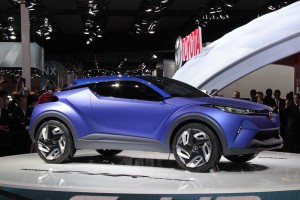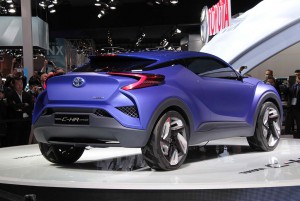
The Toyota C-HR concept debuted at the Paris Motor Show last fall, and it appears to be slotted for the bottom of the maker's CUV line-up.
When Toyota pulled the wraps off the C-HR concept at last year’s Paris Motor Show, it seemed a natural fit in the line-up, especially considering the demand for downsized crossover-utility vehicles.
And now, it appears the C-HR – or something based on that concept – will indeed slot into the bottom end of Toyota’s CUV family, according to a report out of Europe.
A primary market for the new model would be Europe, where it would go up against the likes of the Nissan Qashqai. But what’s unclear is whether there will be an American version, as well.
What might happen in the U.S. is far from certain, but during an interview last month, Doug Murtha, the general manager of Toyota’s youth-oriented Scion brand, said he was a “hand-raiser for any product suitable for the brand.” In particular, Murtha added that he was especially “open” to the idea of adding a small crossover, which would be a first for Scion.
The C-HR concept generated a fair amount of controversy when it debuted last year. Much like the Lexus NX concept before it, the Paris show car opted for an edgy design that would have long been out of character for Toyota. That included its flared wheel arches, squinty headlights, and a coupe-like roofline that plunged towards the rear bumper.
(Toyota debuts the C-HR at the Paris Motor Show. For more, Click Here.)
Lexus toned down its concept only slightly when it launched the production NX, and Toyota officials – taking their mandate from CEO Akio Toyoda – have promised to go with more “passionate” designs, as well. So, many of the C-HR’s basic styling cues could carry over once it heads to showrooms.
Under the skin, the production model is thought to ride on Toyota’s new modular platform known as the New Global Architecture. Much like Volkswagen’s primary architecture, the MQB, Toyota’s platform is expected to be used by as many as half of all the products it builds by 2020. Among other products, it will be the basis for the next-generation Prius hybrid due to debut next year.
(Click Here for details about Toyota’s new Tacoma pickup.)
A key advantage, at least for Toyota, will be enhancing economies of scale, while also making it easier to roll a variety of different products down the same assembly line. For consumers, the New Global Architecture is said to create far more interior space than comparable platforms now in the Toyota portfolio.
Another question is what will power the production version of the Toyota C-HR. The concept model – which some originally thought might replace the RAV-4 – was powered by an updated version of Toyota’s familiar Hybrid Synergy Drive system.
(To see more about how the crossover segment is getting to be more competitive, Click Here.)
While Toyota UK president Paul van der Burgh declined to comment on specific launch plans, he told British magazine AutoCar, “The high growth rate of sales of that sort of vehicle would be very good for us. The concept was excellent and the styling in particular stood out. If such a product were to launch, I’m confident it could be a best seller.”

